Barking at Noises

Dogs bark at noises for a variety of reasons, including being startled, aroused, or worried. This behaviour can be a result of their instinct to alert family members or other dogs to potential threats, a trait that has been reinforced over thousands of years. However, excessive barking can lead to problems for both dogs and their parents, such as complaints from neighbours or landlords, and can also cause chronic stress and sleep deprivation for the dog.
Barking at noises can also undermine other behavioural training, especially if your dog reacts to sounds when you’re not present to provide feedback. For example, if your dog is well-trained to ignore people and dogs during walks but reacts to these sounds while the owner is away, it can hinder the progress of the training.
The Solution
Prevention and Environmental Management
To address the issue of barking at noises, it is crucial to use a combination of prevention, desensitization, and positive reinforcement.
- Reduce Exposure to Noises: When you’re not at home, prevent your dog from hearing noises by closing blinds, playing TV, radio, or using white noise machines. Limit access to the noisiest parts of the house, such as the front door or rooms with loud neighbours. This can help in reducing the stimuli that trigger barking.
- Promote Calm Environments: Ensure your dog gets sufficient exercise and mental stimulation before you leave the house. Teach your dog to settle on a bed or in a quiet area, which can be reinforced during training sessions. Addressing separation anxiety, if present, is also vital as it can exacerbate barking at noises.
Noise Training Sessions
Noise training is a key component in helping your dog become desensitized to triggering sounds.
- Identify Triggering Noises: Determine which noises your dog reacts to most. You can recreate these noises yourself (e.g., recording dog barks, jingling keys, or footsteps) or use online resources like YouTube.
- Start with Low Volume: Begin by making the noise at a low volume. Reward your dog with treats and calm, positive reinforcement when they remain calm. Gradually increase the volume over several sessions as your dog becomes more comfortable with the sounds.
- Reward Calm Behaviour: When your dog remains calm during noise training, reward them with treats and praise. This reinforces the desired behaviour and helps your dog associate the noises with positive outcomes.
- Vary the Location: Start making the noises inside the house, then move to outside locations where your dog can see the source of the noise (e.g., a friend or family member). Gradually increase the silence between noises to mimic real-life scenarios.
Real-Life Training
Consistency is key in real-life training. If your dog starts barking at a noise, here are some strategies to manage the situation:
- Feedback for Every Noise: When you are home and hear a noise before your dog reacts, praise your dog calmly and reward them with a treat. Keep treat jars accessible around the house or wear a treat puch to make this process easier. Initially, provide a treat after every noise for two weeks to see a change in behaviour. Once your dog is comfortable with the noises, you can gradually reduce the treats.
- Use Cues to Interrupt Barking: You can use a cue to interrupt the behaviour, such as the cue “Leave it” or “Quiet” said in a positive tone of voice. Then redirect your dog to what you would like them to do instead, such as saying “Go to your bed/mat”. These cues should be trained in advance.
- Grab your clicker: Click the moment your dog stops or pauses barking, give a treat. Repeat. Note, your click skills have to be pretty on point for this, you must click in the quiet moments.
Long-Term Success
- Use High-Value Treats: For particularly triggering noises, use high-value treats such as chicken, cheese, or hot dogs to maintain your dog’s focus and calmness.
- Maintain Calm Communication: If your dog hears an unusual noise and looks alarmed, communicate calmly and reassuringly. Let your dog know that the noise is not a problem, which can help your dog associate noises with your calm demeanor.
- Consistent Practice: Consistency is crucial. Practice the training sessions regularly, and ensure all family members are using the same techniques to avoid confusing your dog.
By combining prevention, noise training, and positive reinforcement, you can effectively help your dog overcome the habit of barking at noises, creating a more peaceful and less stressful environment for both you and your dog.
Tags
What do you think?
Related Articles

Helping Anxious Dogs Thrive in Urban Environments: The Power of Pattern Games
Urban Anxiety in Dogs Transitioning from a rural to an urban environment can be overwhelming for many dogs. The constant noise, unfamiliar sights, and bustling

Shopping List!
These are items I personally recommend as a dog trainer and think your pups will absolutely love.

Learn to Earn
Are you looking for a way to build a stronger, more respectful bond with your dog? Dr. Sophia Yin’s Learn to Earn Program is a
